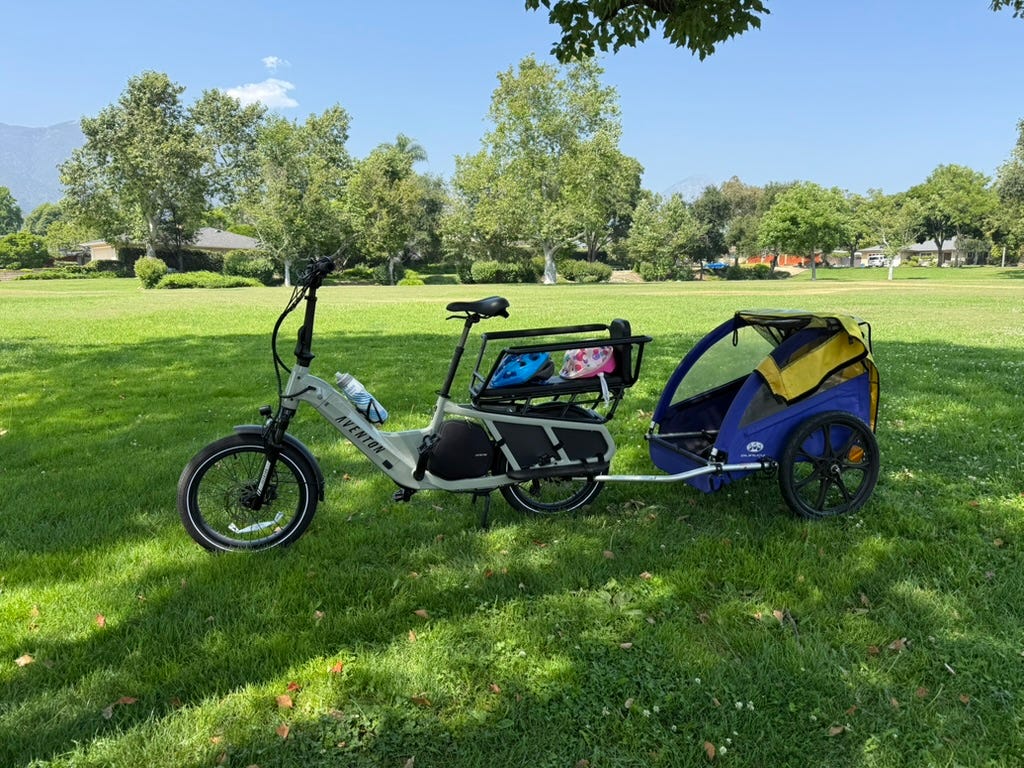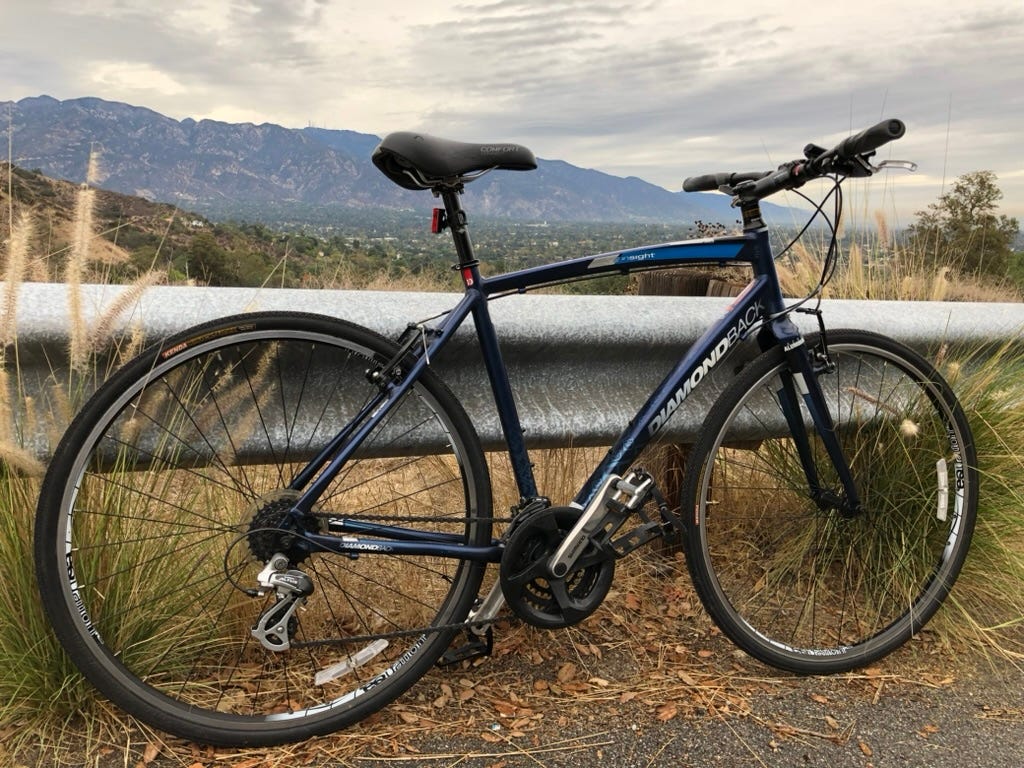An E-bike For The Mind
E-bikes and what they can teach us about AI
Thank you for being here. As always, these essays are free and publicly available without a paywall. If my writing is valuable to you, please share it with a friend or support me with a paid subscription.

I've always had a philosophical objection to e-bikes. It probably started a few years ago when I was out of the saddle, cranking my way up the hills west of the Rose Bowl to reach the top of the hill and a glorious overlook of the San Gabriel Mountains when I got passed by some older ladies calmly powering their way up past me, hardly breaking a sweat. On further reflection, maybe it's not just a philosophical objection.
And yet, as you’ve seen in the picture above, I am now the proud owner of—you guessed it—a beautiful, used-but-new-to-me, cargo e-bike.

As I've been pedaling around town over the past few days, I've been reexamining my beef with e-bikes. And as I've wrestled with it, I've come to a few conclusions that I think are relevant not just to e-bikes but—wait for it, I'm sure you didn't see this one coming either—our use of artificial intelligence too.
Steve Jobs famously imagined the computer as a bicycle for the mind. If the computer is a bicycle, perhaps AI is an e-bike.
Narcissus as Narcosis
In an early chapter of his magnum opus, Understanding Media (with the blog-post worthy title "The Gadget Lover: Narcissus as Narcosis"), Marshall McLuhan makes the case that technological augmentation is simultaneously amputation. He writes:
Any invention or technology is an extension or self-amputation of our physical bodies, and such extension also demands new ratios or new equilibriums among the other organs and extensions of the body.
He goes on to quote the 113th Psalm to argue that by using technologies, we are both formed by them and conformed to them.
Their idols are silver and gold,
The work of men’s hands.
They have mouths, but they speak not;
Eyes they have, but they see not;
They have ears, but they hear not;
Noses have they, but they smell not;
They have hands, but they handle not;
Feet have they, but they walk not;
Neither speak they through their throat.
They that make them shall be like unto them;
Yea, every one that trusteth in them.
"They that make them shall be like unto them." Indeed.
This is the question we had better be asking much more regularly, publicly, and with each other: to what image is our technology conforming us? In recent years, there has been much conversation about the conforming power of algorithmically-powered social media and internet-connected devices that are practically attached to our hands. In so many ways, we accepted them into our lives with a false promise of augmentation without amputation. Only in retrospect are we noticing what’s been cut off.
In the midst of it all, there is hope. We can work to reclaim those things we have lost. Perhaps amputation is the wrong metaphor, and it is more a desensitization from infrequent attention and use. But if we thought that the societal impact of smartphones and social media was significant, just wait till we see the downstream amputations on offer with the promises of artificial intelligence.
As we consider the potential augmentations of AI, we need to hold them in tension with the concurrent amputations. E-bikes and their tradeoffs can offer us some wisdom.
Today, I’d like to riff on three e-bike-inspired perspectives I’m using to think about my technology use.
What: What is being augmented and amputated?
How: How does the augmentation interact with our effort?
Why: What are the values and stories motivating our choices?
1. What: Augmentation and Amputation
The question is not a question of whether a technology has enabling and disabling effects, but rather a question of what they are. Many times, this has to do with your perspective.
In the case of the e-bike, the most obvious augmentation is the ease of travel compared to a standard bicycle. With the addition of a motor, the bike can propel itself with an energy source that supplements (or completely replaces) that of its human rider. If you look at the advertisements for any technology, the augmentations are clear. E-bikes are no different. What’s front and center? Range, speed, and power.
But how to judge the choice depends on the alternative. If I were to trade my road bike for an e-bike, that would indicate a certain set of values and choices. However, in my case, I sold a car and got a cargo e-bike.
The cargo bike will enable me to get around town and accomplish many of the things a second car would have. It doesn't solve any long-range transportation needs, but it will solve the majority of our need for a second car by giving me a more convenient and efficient way to get around town with enough space on the back for the kids and some groceries, too.
Yesterday, I biked to my dentist appointment. It was only a mile away and certainly in reach with my road bike, but the e-bike makes it even more accessible without the car.
Of course, there is always an amputating influence, even if the overall motivation for the e-bike was a good one. It is worth asking why not use a regular bicycle or even walk. Some of the benefits of bicycling, like getting fresh air and being able to move more slowly and intentionally, or taking time to pay attention to your surroundings, are even more accentuated when moving less efficiently.
Whatever our choice, we should be clear about the tradeoffs.
2. How: The Principle of Proportional Augmentation
When we think about what a certain technology does for us, it is also important to consider how that technology is conforming us. The features of the technology matter, but often the conformational power of the technology is significantly influenced by how they are implemented.
Take, for example, the implementation of the electric motor assist on an e-bike. When you first think of an e-bike, you may think of it essentially as a motorbike. Most e-bikes can be ridden without pedals. You can use throttle control to power your forward movement completely from the onboard battery and motor.
But most e-bikes today are primarily designed to be driven using pedal assist. In this mode, sensors on the bike detect the force or speed with which you are pushing on the pedals and use this measurement to supplement, not totally replace, the power being exerted by the rider through the pedals in the old-fashioned way. In this mode, the assistance from the motor is proportional to the effort that you, as the rider, are putting in.
Functionally, there is little difference between the throttle and the pedal assist. In both cases, the motor is giving you a significant boost. Philosophically, however, there is a big difference. In pedal assist mode, you are still required to exert some effort. You have some choice over how strong the assistance will be, but in any situation, the level of assistance remains directly connected to the amount of effort you put in.
This sort of design strategy is important to consider as we think about AI, especially in educational contexts. If we eliminate the connection between effort and results, we are training ourselves to become reliant on our AI tools. Just like only using the throttle on our e-bike will deprive us of the health benefits of exerting ourselves and cycling, using AI in this way will sacrifice opportunities we have to build our cognitive and intellectual skills.
3. Why: The Ruthless Elimination of Friction
One last question we should be asking as we choose our technology is why we are choosing to use it. In many ways, these three questions cannot be disconnected from each other. The what, how, and why are interconnected.
In the case of my e-bike, am I really getting it to replace my car, or will it just serve as an excuse to ride my road bike less? As we think about AI, is the thing it will accomplish for us worth doing the old-fashioned way? Why exactly are we choosing to outsource it? What does our choice indicate about our values?
In my case, I feel pretty justified in my purchase, having towed all three kids around town multiple times already. My previous bike just didn’t have the space to fit all of them, and trying to tow a bike trailer behind a cargo bike with a five and almost four-year-old on the back without some assistance just isn’t a tenable solution.
But enter a little electronic boost, and the bike has new life again. Last week, we rode to get ice cream as a family on bikes. I had a smile on my face for the rest of the weekend. Yesterday, we explored a new neighborhood and checked out a new park. All these things were enabled by the e-bike and the additional boost of power that comes with it.

At the end of the day, we must remember that innovation is a bargain. We often consider what technology promises to enable for us, without considering what it will almost certainly disable.
Most of the time, we fail to stop and consider the tradeoffs. Perhaps e-bikes may give us a metaphor to frame our thinking.
Got a thought? Leave a comment below.
Reading Recommendations
I’ve been intrigued and encouraged by the work that The Cosmos Institute is doing to ask thoughtful questions about AI. Their mission to cultivate philosopher-builders resonates deeply with my own and the kind of impact I hope to have at Harvey Mudd. Brendan McCord’s latest, where he uses Wilhelm von Humboldt as a frame to think about our future with AI, is worth a read.
The Book Nook
Slowly but surely making progress on The Devil and the Dark Water. Getting more and more interesting, page by page.
The Professor Is In
Hard to believe we are quickly coming up on the end of four weeks of summer research already. It’s always amazing to see how much progress my students make so quickly during the summer, and great fun to get to dig into building and debugging optical systems with them.
Leisure Line






Some pies from the weekend. Went with a slightly higher than usual hydration (65%), which led to some nice chewy texture on the crust.
Still Life
#1 and I went to see the Mets last week at the Dodgers game. We took the train in from Claremont and the bus to the game, which was fun. The good guys lost, but we took the season series from LA and were in it all four games of the series we played out west. Metsies are just fun to watch this year, and boy, Alonso is just ripping the cover off the ball lately.






Interestingly in the UK e-bikes _must_ be propelled with human energy and can only support you up to 15.5mph / 25kph. Otherwise, it's a moped and you need to get a drivers license / register it as a motor vehicle. There are 'jailbroken' bikes where you can just use the motor but the police are cracking down on those as they're proving to be a public safety issue. https://www.theguardian.com/lifeandstyle/2025/sep/04/britains-e-bike-boom-desperation-delivery-drivers-and-unthinkable-danger
It's funny- I had the e-bike thought a few days ago-but less charitably. In my neck of the woods a particular breed of especially fat-tired, awfully fast, never-actually-seen-it-pedaled e-bike has been surging in popularity, and functionally has turned into a way to get away with driving a small motorcycle on the bike and walking paths- a weird netherworld device that mostly just serve to muck things up. It's less old people being enabled and dads towing a pack of kids through nature and more almost being run over by disaffected teenagers.
I dunno- the longer this hype cycle goes on the more that chatbots really just seem like a bad tool, regardless of their technical sophistication. More amputation than augmentation. They do too much if you are trying to improve yourself (synthesized homework text is one of their major markets) and do too little if you have actual work to do (not enough knobs to turn for creatives trying to express themselves, and fake law citations will never do). Just like with the metaverse and crypto and all the rest, the giant pool of money is doing its best to drive uptake through sheer noise with a product that might just be kind of bad in a durable way, or at least kind of niche (given how much coding is boilerplate in something besides your native language, sure, maybe the boilerplate generator is a nice thing to have).
Your thoughts reminded me of a good Nicholas Carr essay on good and bad tools that's been rolling around my head of late- on the off chance you haven't read it yet, you might enjoy it: https://www.newcartographies.com/p/the-love-that-lays-the-swale-in-rows